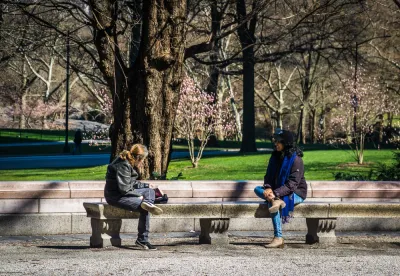An interview with Michael Berkowitz, former executive director of 100 Resilient Cities, finds a path to the light at the end of the tunnel.

Michael Berkowitz, former executive director of the nonprofit consultancy 100 Resilient Cities, speaks with Laura Bliss at CityLab for ideas about "how communities will survive the aftermath, as well as for opportunities to strengthen resilience now in the face of social and economic disruption."
According to Berkowitz, cities should be "linking various objectives together" to ensure that specific interventions strengthen the city across multiple areas. That's a key for all forms of resilience, according to Berkowitz, not just the kind of resilience necessary in response to the COVID-19 pandemic. For examples of the kind of governance he recommends, Berkowitz includes New York state, now the epicenter of the pandemic in the United States, where state and regional policies have driven the response, while mayors, like New York Mayor Bill de Blasio have taken the back seat.
Berkowitz also takes a position in the debate about the benefits and risks of density in a time of pandemic, as has been frequently discussed in the media in recent weeks, and says that, eventually, when cities reopen, density will benefit a recovery. In Berkowitz's words:
And when that next phase hits, that’s when we’ll see benefits of urban resilience — of neighbors checking in on each other, strong neighborhood institutions, diverse economies, good governance. Those things will pay off in ways that will let us rebound from this situation and hopefully let us build stronger communities.
The interview continues to touch on current opportunities to prepare for the recovery, including opportunities at the hyper-local level.
FULL STORY: What a Coronavirus Recovery Could Look Like

Analysis: Cybertruck Fatality Rate Far Exceeds That of Ford Pinto
The Tesla Cybertruck was recalled seven times last year.

National Parks Layoffs Will Cause Communities to Lose Billions
Thousands of essential park workers were laid off this week, just before the busy spring break season.

Retro-silient?: America’s First “Eco-burb,” The Woodlands Turns 50
A master-planned community north of Houston offers lessons on green infrastructure and resilient design, but falls short of its founder’s lofty affordability and walkability goals.

Test News Post 1
This is a summary

Analysis: Cybertruck Fatality Rate Far Exceeds That of Ford Pinto
The Tesla Cybertruck was recalled seven times last year.

Test News Headline 46
Test for the image on the front page.
Urban Design for Planners 1: Software Tools
This six-course series explores essential urban design concepts using open source software and equips planners with the tools they need to participate fully in the urban design process.
Planning for Universal Design
Learn the tools for implementing Universal Design in planning regulations.
EMC Planning Group, Inc.
Planetizen
Planetizen
Mpact (formerly Rail~Volution)
Great Falls Development Authority, Inc.
HUDs Office of Policy Development and Research
NYU Wagner Graduate School of Public Service




























